A sharp, balanced and versatile kitchen knife is a must-have for any home chef. The best knives have more than one cutting function and make quick work of the food they are designed to slice or dice. Kitchen knives come in a dizzying array of styles and construction and are definitely not a one-size-fits-all purchase decision. To make cutting food enjoyable and easy, it’s important to choose a quality kitchen knife that fits individual cooking preferences.
With the goal of helping you select the right kitchen knife for your particular needs, we invested 32+ hours into researching and comparing over 100 kitchen knives to create this list, buying guide and comparison chart.
Best Overall: Miyabi 34373-203 Birchwood SG2 Kitchen Knife
The Miyabi Birchwood is our top pick and we give it our highest recommendation. This exceptionally well-crafted, high-quality kitchen knife has 10o layers of flexible steel combined with an ultra-hard core. It is extremely well-balanced and has a genuine birchwood handle, making it easy to maneuver for all types of cutting jobs.
Japanese designed and constructed, the Miyabi Birchwood has 50 layers of steel on each side of its blade that covers a SG-2 micro-carbide steel core. This knife is hand-made using a traditional Japanese, three-step process called honbazuke, which involves sharpening twice and then polishing. It features a hamon edge, which is something that can also be seen on Japanese samurai swords, and is an easily visible line that shows where the outer layers meet the core.
Aside from being incredibly sharp, the Miyabi Birchwood really shines when it comes to comfort and security. The handle is made of real natural birch wood and is in a symmetrical D-shape, allowing it be used equally comfortably by both right and left handed people, as well as providing a secure grip . This natural wood handle rejects moisture and oils to help you maintain a secure grip while cutting various ingredients. Read reviews on Amazon >
Shun TDM0706 Premier 8-Inch Japanese Kitchen Knife
The Shun Premier is another very high quality, all-purpose kitchen knife that can make quick work of slicing meat and chopping vegetables. This Japanese designed knife has a hand-hammered finish and pakka wood handle to add grip and comfort.
The Japanese method of construction on this knife is called tsuchime, which involves giving the blade a hand-hammered finish that prevents food from sticking to the surface of the blade and causing drag while slicing. This makes slicing and dicing with this knife incredibly smooth and quick. The handle has an oblong shape and is made of hardwood infused with resin, which makes it resist moisture for a safer and more secure grip.
The Shun knives are made in Seki City, Japan, which is the home of samurai sword making. It is constructed in a similar fashion to these swords as well, with the kasumi method. This construction style covers a super hard core of high-carbon steel with more flexible layers of steel. The exterior then takes on a filmy appearance that reflects the meaning of the word kasumi, which is mist. In practical terms, the kasumi method yields a knife with a very sharp edge that is easy to maintain.
Aside from its handsome appearance, the strongest attributes of this knife are its light weight and how easily it cuts through both meat and vegetables. For those worried about staining, this knife resists stains through a well-polished and very hard exterior. Read reviews on Amazon >
Wusthof 4596-20 Classic Ikon Chef Kitchen Knife
The German-made Wusthof Classic Ikon has an ergonomic design and precision-forged quality. The blade has a 14 degree angle on each side to make slicing and dicing quick and easy. Stain resistant, high carbon steel help make maintenance simple.
Made in Germany in the famous knife-making town of Solingen, the Wusthof chef knife is constructed from one sheet of chrome molybdenum vanadium German stainless steel with high-carbon alloy to provide stain resistance and help it keep its edge. The handle has an ergonomic design formulated after discussion with professional chefs. The blade is hand-honed to be extremely sharp with a long-lasting edge. A signature characteristic of Wusthof knives is the finger guard, which offers slip protection and helps the knife feel balanced in the hand.
The 14 degree cutting edge on this knife is fairly unique compared to other European made knives. Many others have a 20 degree edge. The 14 degree edge allows it to more easily slip through ingredients without catching or dragging. However, compared to the Japanese knives above, it tends to stick more to ingredients such as vegetables and fruit. The ergonomic handle with a wider base is a great feature for more novice cooks or those with difficulty gripping. Read reviews on Amazon >
4 Best Value: Global G-2 8-Inch Chef Kitchen knife
Out of all the kitchen knives that we looked at, we felt the Global G-2 delivered the most value for money spent. This 8″ knife is a classic chef’s blade with a lightweight construction for easy maneuverability. It features a comfortable, molded handle for fatigue-free use and its single-piece, seamless design helps resist staining and food sticking.
For a knife that isn’t completely steeped in ancient Japanese or German knife-making lore, the Global G-2 is an especially well-made knife. They came upon the scene as a Japanese version of European-style knives featuring a more European look with a Japanese-style construction. It nevertheless has a number of high-tech features to put it right next to those type of knives in quality.
It is made from one piece of Cromova high-carbon stainless steel to provide sharpness and stain resistance. The edge is honed to a super sharp 12.5 degree angle, which is generally used by quality Japanese knife-makers, and has a double-bevel that allows it to be easily used by both left and right-handed people. In addition, its handle, one of Global’s signature features, is made of steel with a dimple pattern that yields a secure and comfortable grip. A precise calibration allows the handle to perfectly offset the blade’s weight for excellent balance. Read reviews on Amazon >
5 Tojiro F-808 DP Gyutou Kitchen Knife
The Tojiro DP Gyutou is one of the lightest kitchen knives on the market, and is made using a method called honwarikomi. The honwarikomi method involves encasing a piece of carbon steel with stainless steel. This makes the blade sharp and durable like a regular carbon steel knife, but with an easy to clean exterior.
Made in Niigata, Japan with both modern and traditional craftsmanship, the Tojiro DP Gyutou is made from a top-quality steel that is 13 percent chromium and sourced from Sweden. In addition, the knife’s handle is made of Eco wood, which provides even more resistance to water than natural wood handles, and its edge is completely even so both right and left-handed users can wield it comfortably.
The main drawback to this knife is its softer stainless steel exterior. While it resists stains quite well, it is susceptible to scratches on the surface, although this only mars the surface appearance of the knife and doesn’t really affect its cutting edge. With its good balance, affordability and razor sharpness, the Tojiro DP Gyutou is an excellent choice for beginning home chefs just getting started on their knife collection. Read reviews on Amazon >
6 Kutt 8-Inch German Professional Kitchen & Chef’s Knife
The Kutt 8-Inch is a German designed value brand with an exceptional edge and ergonomic pakka wood handle that gives the impression of a more high-end knife. And as a nice added touch, the manufacturer includes an odor-removing metallic soap bar to making cleaning easy.
The blade of this knife is constructed from a combination of carbon, chrome and quality German steel. This mix provides stain resistance, durability and a long lifespan. The handles are made from African-sourced pakka wood and this material is known for stable strength and balance. The feeling of the knife is also light and balanced, and its edge is easily maintained for long-lasting sharpness. The odor removing soap that comes with the knife is capable of removing some of the strongest smells, including garlic, onion and seafood. Additionally, the Kutt has enough versatility and balance to cut a wide range of ingredients, from bread and meat to vegetables.
As a value knife, the Kutt 8-Inch performs well with both cutting tomatoes and the paper test where a knife is pushed through a sheet of paper. At 1.4 pounds, this is also the heaviest knife on our list, so this is definitely more suited to those who prefer more hefty-feeling knives. Read reviews on Amazon >
7 Best Budget Model: Victorinox 45520 Fibrox Pro Kitchen Chefs Knife
For those of you shopping for a kitchen knife on a very limited budget, we recommend the Victorinox Fibrox Pro. This multi-purpose knife was designed to tackle a wide range of cutting chores. It features a laser tested edge and an ergonomic handle to provide a tough grip in slippery conditions.
Victorinox is a Swiss company known for making good quality budget knives, and this knife is certainly no exception. Constructed with high quality European steel for a lighter weight that reduces hand and wrist fatigue, the Victorinox Fibrox Pro reflects a design style more akin to German knives with a curved blade to perform the rocking method of chopping. At the same time, the spine has a flattened shape to allow you to easily push down through harder foods such as squash. Additionally, its handle is patented to provide a secure grip regardless of the user’s hand size and will resist trapping food particles and odor.
For a budget knife, it has a fairly sharp edge and is comfortably balanced, but it will need to be honed on a regular basis with a honing steel. Essentially, with this knife you are getting about 80 percent of the performance of a good German or Japanese knife at about 30 percent of the cost. Read reviews on Amazon >
8 Soufull Japanese 8-Inch Stainless Steel Gyutou Kitchen Knife
The Soufull 8-Inch is another decent knife that you can buy without hurting your wallet. This stainless steel, Japanese made knife has a decently sharp blade with a Rockwell hardness score of 62, as well as an ergonomic handle made of pakka wood.
The Soufull is constructed out of layers of high carbon stainless steel to create a strong, durable and sharp knife. The handle is made of pakka wood for a comfortable grip and handsome appearance. With between 16 and 18 percent chromium, the blade is designed to strongly resist corrosion, and has an attractive swirl design imprinted on its surface, which may be appealing to those who like their knives to look as good as they function.
Like many Japanese knives, the Soufull is very well-suited to delicate cutting tasks, such as slicing thin pieces of raw fish, but isn’t very good for cutting bones or other rough surfaces. In addition, the knife should always be hand-washed and not used on hard surfaces like granite. Also, be aware that it has a partial tang which makes it less suited to heavy, repetitive use. Read reviews on Amazon >
Buying Guide: How To Choose The Best Kitchen Knife
Even the most avid home chef can be terribly uninformed about shopping for knives. Super sharp knives are intimidating, but dull knives are frustrating and can make food prep a chore. To make things even more complicated, kitchen knives come in a wide range of styles, makes and prices. There are a number of terms to sort through, from stainless steel to high carbon, from stamped and forged blades, and of course, the ageless battle between Japanese and German knives.
General Information About Kitchen Knives
Kitchen knives have a pointed tip at the very end of the knife and this function is so it can pierce and separate while cutting. The edge of the knife is the bottom part of the blade and is the sharpest portion of the knife. The heel of the knife is the area near the handle and is the thickest part. This part of the knife helps push the blade through tougher ingredients. Another term is the tang of the knife. This part stretches from the blade into the handle to give the knife more stability. Full-tang knives are often recommended for consistent and heavy use as the handle is more likely to last. Many knives are marked full-tang, but it is also easy to see if the metal part of the knife extends fully through the top part of the handle.
The handle of a knife is the part gripped by the user. It can be made from just about any material, such as wood, plastic, composite or metal. Wooden handles are commonly accepted as the type with a superior grip, especially in wet situations. However, they can be harder to keep clean. Stainless steel is easier to keep clean, but the grip can become compromised with moisture. High-end knives typically do not have plastic handles, but either wood or metal.
The bolster of a knife is sometimes also called a finger guard. This is a raised point in between the knife blade and the handle. The function of this part is to provide stability, balance the knife and offer some protection in the event of slippage. Some knives feature more prominent bolsters than others.
What Type of Knife Makes the Best Kitchen Knife?
The eight inch chef’s knife is generally considered to be one of the most versatile knives available and a quality version of this knife can go a long way towards most cutting tasks. One way to look at it is that a person could buy a number of specialized knives in a mid-price range, but a high-end, eight inch chef knife could do the same jobs and last a lot longer. Consider the following features when shopping for a kitchen knife:
All of these features depend largely on individual preference and the usual cutting tasks a person might put the knives through on a regular basis. Remember that all quality kitchen knives should be hand-washed and stored in a sheath or knife-block to keep them sharp and durable.
Knife Material Type
Different knife blade materials affect several factors, including sharpness, edge maintenance, feeling and strength.
Carbon steel combines carbon and iron to make a very hard, but relatively brittle knife blade. The top selling point of this material is that it can hold a sharp edge for a prolonged period. Its drawbacks include easy staining, rusting and general discoloring after enough use. When using a carbon knife, it’s important to immediately clean the blade after use and remove all moisture. Another way to maintain it is to coat it with mineral oil before storing it. Even though the knife does need extra care, many users find the long-lasting sharpness worth the work.
Stainless steel lives up to its name in that it resists staining and rust. It’s also less prone to breakage as it is softer than carbon steel. However, as a softer metal, the edge will also wear down and lose sharpness a lot quicker than carbon. Stainless steel knives are often considered good starter knives as they typically cost less. Essentially it’s a trade between sharpening more often and taking meticulous care of the blade after each use. The trade-off isn’t completely cut and dry either, but rather a flexible scale of what every consumer prefers between price, maintenance and cutting performance.
Ceramic knives do not rust or stain, plus they are durable and maintain a sharp edge for a long time. Even though they don’t require regular sharpening, the edge will eventually get dull and the sharpening process is rather specialized. Ceramic is also very hard and brittle and thus the knives are prone to breaking if dropped on a hard surface. They are also bad choices for cutting through very hard foods such as bones or frozen meat. The best use for ceramic knives is for slicing or chopping vegetables and on very acidic foods such as citrus. They also have the unique ability to resist trapping flavors from food and thus can be switched between something like fruits and vegetables without affecting the flavor of either.
Examining the Steel Used in Kitchen Knives
On the surface, it would seem easy to decide on either a stainless steel or carbon steel knife. However, these two types are not as simple as they look. There are actually hundreds of different steel types used in the construction of kitchen knives. Some are amazingly high-tech and provide top performance, but there are many others that are barely worth their inevitably low price.
To give an example, a knife might be labeled as high-carbon stainless steel and usually contains an amount of chromium between 13 and 18 percent and some other trace metals. Manufacturers will often try to set their knives apart by adding in various terms that might sound impressive to shoppers. It’s important to remember that iron is the beginning of all steel and by itself is not a particularly great material for a hard, sharp knife blade. However, the amount of carbon added makes the knife harder and sharper. All steel contains some amount of carbon.
Manufacturers thus strive to tout their steel as a high-carbon, but this can simply mean steel with greater than half a percent of carbon. In truth, an actual high carbon knife should have at least .8 percent of carbon. The higher the carbon, the harder the blade and the longer it will keep its edge. On the flip side, more carbon makes the blade less able to resist stains and more brittle.
Other Added Metals
Looking at knife descriptions will often yield terms like chromium, cobalt, manganese, nickel, silicon and tungsten. But what do each of these metals do?
Chromium is commonly used to resist corrosion, i.e. rust. Any steel description touting at least 12 percent of this material is considered stainless.
Cobalt helps increase the hardness and strength of regular steel. If this ingredient is listed in a knife description, it is likely that it is a top quality product.
Manganese is found in most knives and it adds hardness, durability and structure.
Nickel isn’t commonly used in high-end knives so its presence in a description usually indictes a low-quality product.
Silicon is another material that helps add strength and hardness.
Tungsten adds toughness to steel and gives it a great ability for a hard edge. A material that adds similar features is vanadium. Either one is a good indicator that the steel is high quality.
Most high-quality knives provide detailed information about their materials and construction, while low-quality knives may say very little abut this process.
Knife Blade Construction De-Constructed
It’s not just the material of a knife blade that’s important, but also how it’s made. Very simply, the two main methods are stamping or forging. Stamped blades are cut out of a steel roll and then attached to handles. They do not have bolsters and are usually somewhat thinner than forged blades. These knives also tend to be light and not as pricey as forged blades.
Forged blades are products of craftsmanship and need more skill in their construction. This is why they are more expensive, but also more quality. In forging, a piece of steel is heated and then shaped with a hammer by hand. These knives also have bolsters that balance the blade and the handle as well as protect fingers. Such knives tend to be heavier, which can yield more performance, but also fatigue from long use. Forged knives usually also have full tangs. This makes them more durable and more comfortable in the hand.
Modern Production vs Traditional
Traditionally made forged knives are often described as the ideal knife produced with superior craftsmanship while machined knives are described as cheap, light and largely worthless. However, in the present day, there are better methods of mass-producing knives that don’t render them quite as worthless. One new method cuts knives out of high-alloy steel and then they are precisely ground. Essentially they begin their lives as stamped knives, but are hand-finished to create a product very equal to a forged knife. These knives are lighter than the traditional forged knife, which reduces the fatigue from heavy use.
German vs Japanese
Any foray into the knife world will show that German and Japanese knives are often held up as the best quality knives in the world and every chef may have their preference on which is better. It’s important to first recognize the difference between traditional style Japanese knives and the modern styles that fuse Japanese design with Western. Traditional Japanese knives look very much like swords with a long, slender appearance and one sharpened edge. Modern style knives have double beveled edges that allow them to be used either right or left-handed. Because of this, Japanese and German knives currently have more similarities than differences and in most cases, consumers will find features to appreciate in both.
However, there are some definite differences between the two knife styles, including the cutting angle, shape, material and weight.
German knives typically have a cutting angle of about 20 degrees. This usually works well with the rocking method of chopping and the knives are also heavier to aid in this method. German knives have a heftier feel and are usually made with softer steel, which gives users a very durable blade that can easily deal with harder foods.
Japanese knives are known to be lighter and the cutting angle is often between 12 and 16 degrees. The straight edge makes slicing and chopping easy. These knives typically do not have bolsters and are constructed much thinner, which contributes to the lighter feel. Japanese knives are generally more expensive than German knives.
So which knife is better? It depends on the user and individual use. German knives can handle tough cuts of meat and bones, but can quickly cause fatigue when used on more delicate tasks such as thinly slicing vegetables or delicate fish.
Comparison Chart
Our Top Pick
$$$$$
Micro-Carbide MC63 Steel
Natural Birchwood
Available in 6, 8 or 9 in.
1.18 lbs
Best Value
$$$
Cromova 18 Stainless Steel
Stainless Steel
8 in.
0.49 lbs
Best Budget Model
$
High-Carbon Stainless Steel
Plastic
Available in 5, 7.5 or 8 in.
0.55
Top Rated
$$$$
Damascus & VG10 Steel
Pakkawood
Available in 6 or 8 in.
0.5 lbs
Top Rated
$$$$
X50 CR Mo 15 Steel
Wood & Stainless Steel
Available in 6, 8, 9 or 10 in.
0.56 lbs
Very Good
$$
VG10 (Core) & Stainless Steel
Wood & Stainless Steel
Available in 8.2 or 10.5 in.
0.35 lbs
Good
$$
German Stainless Steel
Pakkawood
8 in.
1.4 lbs
Decent
$
7Cr17mov Stainless Steel
Pakkawood
8 in.
0.5 lbs





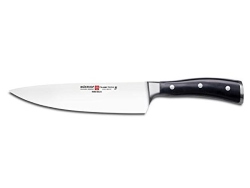
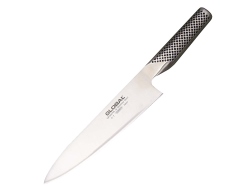
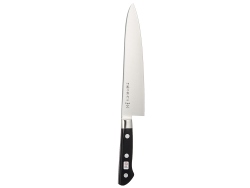
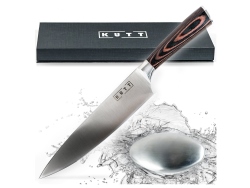
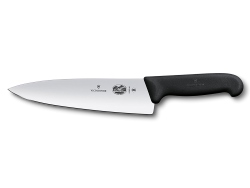
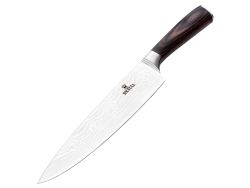
 Top 5 Kitchen Knife Sets
Top 5 Kitchen Knife Sets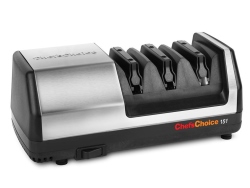 7 Best Knife Sharpeners
7 Best Knife Sharpeners Top 4 Cutting Boards
Top 4 Cutting Boards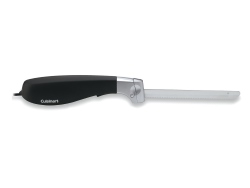 3 Best Electric Knives
3 Best Electric Knives